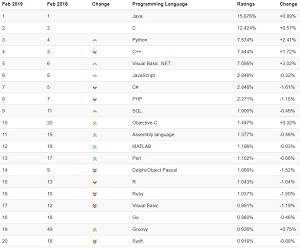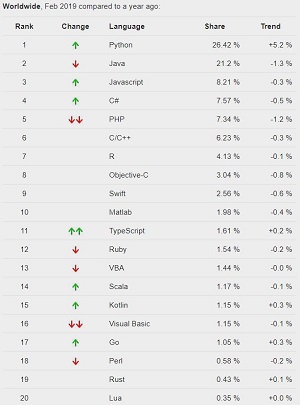News
What's New in Programming Language Popularity
- By David Ramel
- February 12, 2019
February 2019 reports on programming language popularity from TIOBE and PYPL are out, with the former tracking the rise of Groovy and the latter contrasting the trends of Python (up) with PHP (down).
The TIOBE index, based on search engine data, notes that Groovy has regained a top 20 position after falling out of that echelon.
"This dynamically typed language that is compatible with Java entered the top 20 for the first time at the end of 2016," TIOBE said. "At that time it was pushed because scripts for the most popular Continuous Integration tool Jenkins are mainly written in Groovy. Now it is back. Apart from Jenkins also the build automation system Gradle, which is getting popular as well, is using Groovy for its scripting. In general more and more glue software is written in Groovy. Next to Groovy, it is also worth mentioning that Hack has entered the top 50 and TypeScript (temporarily) has fallen back to position 57 this month."
The September 2018 report from TIOBE foreshadowed the re-entry of Groovy into the index's top 20, saying: "Other interesting moves this month are: Rust jumps from No. 36 to No. 31, Groovy from No. 44 to No. 34 and Julia from No. 50 to No. 39."
The rise of Groovy has also been tracked by other reports. For example, in the big 2018 Stack Overflow Developer Survey, Groovy came in at No. 24 on the list of most popular technologies, listed by 4.3 percent of respondents.
 [Click on image for larger view.]
TIOBE Index for February 2019 (source: TIOBE Index)
[Click on image for larger view.]
TIOBE Index for February 2019 (source: TIOBE Index)
However, on Stack Overflow's list of languages associated with the highest salaries worldwide, Groovy placed No. 4 at $72,000, behind F#, Ocaml and Clojure.
Another huge developer report, published by GitHub last October, noted the increasing popularity of Groovy: "The fastest-growing languages were Kotlin, HCL, TypeScript, PowerShell, Rust, CMake, Go, Python, Groovy and SQLPL."
 [Click on image for larger view.]
PYPL Index for February 2019 (source: PYPL Index)
[Click on image for larger view.]
PYPL Index for February 2019 (source: PYPL Index)
Meanwhile, the PYPL Index (PopularitY of Programming Language Index) -- based on Google Trends data -- doesn't list Groovy at all. It shows Python repeating as No. 1 with a 5.2 percent upward share from a year ago, while PHP fell off 1.2 percent. A chart comparison between the two languages shows a climbing Python surpassing PHP around 2016, with the separation gap between the two still growing.
"Worldwide, Python is the most popular language, Python grew the most in the last 5 years (16.2 percent) and PHP lost the most (-5.6 percent)," PYPL said.
About the Author
David Ramel is an editor and writer at Converge 360.